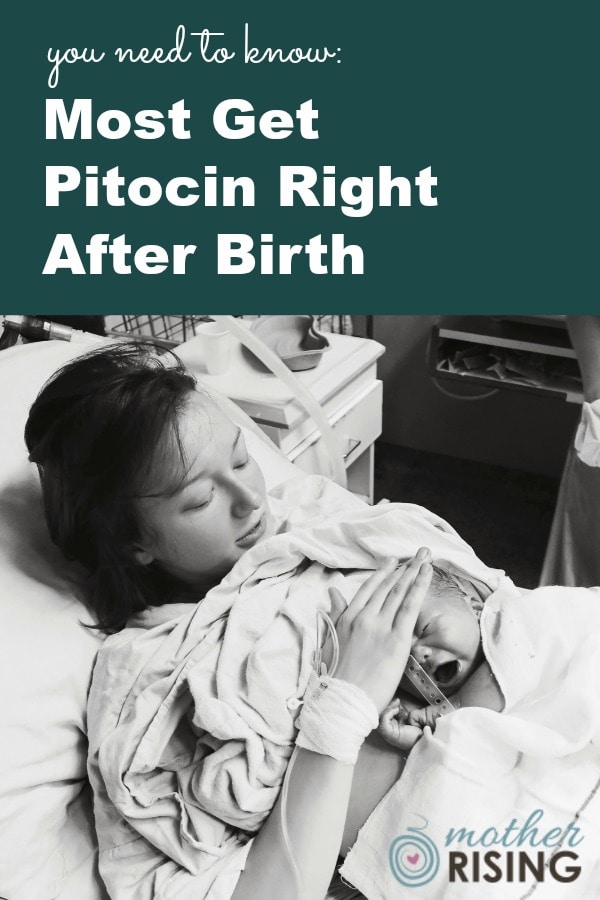New parents are shocked to discover most women that have a hospital birth will receive pitocin right after birth. Pitocin is routinely given to all women to reduce the chance of postpartum hemorrhage.
Postpartum hemorrhage is excessive bleeding that occurs within 24 hours after birth and is a major contributor to maternal mortality in low-income countries.
Are parents shocked that care providers want to reduce excessive postpartum bleeding? No.
Some expectant parents are shocked because their birth plans specifically state their preference to not use pitocin in labor. They had no idea they needed to address pitocin administration right after birth as well.
Other new parents are shocked because, while they were consumed with meeting their new baby for the first time, they had no idea pitocin was put in their IV.

You Need to Know: Most Get Pitocin Right After Birth
The most common source of postpartum bleeding originates from the place in a woman’s uterus where the placenta was attached. During the third stage of labor, once the placenta is delivered, the uterus should contract down and feel like a firm grapefruit.
If this does not happen, it is called uterine atony or what my midwife refers to as a “boggy uterus”. At this point, excessive bleeding is likely to occur from the wound where the placenta once was.
Pitocin®, a synthetic form of oxytocin, is routinely given to women immediately following birth, during the third stage of labor, to ensure the uterus stays firm and contracted down, allowing for only minimal bleeding.
Keep reading.

How Do Care Providers Handle Postpartum Hemorrhage?
There are two schools of thought in regards to preventing and treating postpartum hemorrhage (PPH). Which school of thought does your care provider follow?
Active Management
With active management care providers…
- administer medications such as Pitocin to all women
- practice early cord clamping (although this practice is less prevalent now because of the recent push towards delayed cord clamping)
- use controlled cord traction to deliver the placenta (SOURCE)
PROS
- Studies show active management is effective at reducing the chance of PPH. Yay! (SOURCE)
- Active management is an effective way to ensure the reduction of PPH across the board where mother and baby centered care is not the norm. This is especially the case in hospital settings with a large patient numbers and high turnover.
- Active management is effective with women that are high risk for PPH.
CONS
- Not every woman hemorrhages after birth. Because of this, many women will receive pitocin or other medications, early cord clamping, and controlled cord traction unnecessarily.
- Pitocin is linked to postpartum depression.
- Early cord clamping is associated with anemia in babies.
- In my experience, excessive cord traction can cause retained placenta, which ironically can cause postpartum hemorrhage.

Expectant Management
With expectant management care providers…
- watch for signs of placental separation from the uterus
- allow the placenta to deliver spontaneously
- administer interventions and medications such as pitocin on an as needed basis (SOURCE)
PROS
- For low risk women, there was seemingly no difference in excessive bleeding between those who received expectant and active management. (SOURCE)
- Expectant management ensures women will not receive unnecessary medications and interventions.
- A good choice for women that want to avoid pitocin, early cord clamping, and excessive cord traction.
CONS
- Expectant management may not be a wise choice for women that are high risk for PPH.

Risk Factors for Postpartum Hemorrhage
Do you know your potential risk for PPH? Talk with your care provider to find out and discuss this topic further.
(This link has a neat and tidy chart showing some risk factors for PPH.)
Pitocin During Labor Increase Risk of PPH
While researching PPH and how most women receive pitocin right after birth, I stumbled across something that parents need to know.
Did you know that women with a severe postpartum hemorrhage because of a “boggy uterus” were given significantly more pitocin during labor compared to others? TRANSLATION: If you are induced with pitocin, or are put on pit to “ramp things up”, your risk for PPH will go up.
I find this discouraging, mainly because this particular risk of pitocin is not something that care providers communicate to parents. Which brings me to my next point.

Informed Consent for Pitocin Right After Birth
Sure, I want there to be less use of pitocin, especially for low-risk women. However, I have bigger issues with the lack of informed consent and shared risk between care providers and parents.
“I specifically asked for NO PITOCIN and found out later that during the commotion right after birth – when I was staring at my beautiful newborn and oblivious to the chaos around me – that they did indeed give me pitocin anyway. That’s the only “drug” I got during my entire labor and it infuriates me since it was clear in my birth plan, and stated several times by myself and husband to the staff… but they did it anyway, and I was charged for it.” Kaylyn L.
As a doula there are times when I see nurses hooking up a pitocin drip without mentioning it to their patients. While this unfolds, I typically ask my client if they have any questions about the pitocin that’s being put in their IV.
As happy I am to be there to facilitate informed consent, what about all the other parents that remain uniformed?
“Women could be given information on the benefits and harms of both methods to support informed choice.” (SOURCE)
I’m going to go out on a limb here 😉 and rephrase the above quote. Women SHOULD be given information on the benefits and harms of both methods to support informed choice.
“I hemorrhaged badly after my third (birth center) and required three drugs including Pit. With my fourth, another birth center water birth, I planned to have Pit immediately after birth because of my risk factors, and I have no regrets.” – Jeannie P.
Satisfaction Matters
Research has shown that the more a woman is part of the decision-making process during birth, she will be happier about the outcome, no matter what happens. She will also be more likely to have a vaginal delivery!
“It is also suggested that active involvement of pregnant woman in decision-making process for the delivery method will increase the rate of vaginal birth after c-section and decrease c-section rate and improve the degree of maternal satisfaction after delivery.”
Plain and simple, if a woman is ignored she will be unhappy about her experience giving birth, which can have long lasting consequences in the way she mothers, her self-esteem, and future pregnancies (among other things).

You Need to Know: Most Get Pitocin Right After Birth
Heads up, women routinely get pitocin right after birth, often without any knowledge.
Do your research and form a birth plan. Use this birth plan to speak with your care provider to facilitate informed decision making and shared risk. If necessary, fire your care provider and find a better one. Hire a doula.
You’ve got this!

Kelly
Wednesday 3rd of July 2019
Hi! I've been pouring over your website for a couple days now, what a wealth of information! Thank you! I have one quick question and one long one, quick one first: you mentioned under Expectant management that the card provider watches for signs of placental separation, do you know what these signs are? Long question: I have a history(2x) of PPH with retained placenta, both were remedied with pit and massage (ouch!). I'm 15 weeks pregnant with #3 and am hoping to avoid that situation this time. I delivered both babies without pain meds and I'd really like to deliver my "last one" without ANY meds at all. I am drinking rrl and nettles tea (with my midwives "ok") this time around and looking into other natural things I can do to strengthen my uterus. I've seen a couple different "birth preps" that seem questionable as far as safety and one placenta release tincture that I'm willing to try. To the question! In your experience do you know of anything that might be beneficial for a situation like this?
Lindsey
Saturday 6th of July 2019
Do you think that your retained placenta had anything to do with your care provider tugging on the cord (aggressive cord traction)?
Brittany
Wednesday 12th of June 2019
I had a natural birth even though my OBGYN wanted to induce me. I said no. After the Golden hour, I found out that one of the nurses put pitocin in my IV WITHOUT telling or asking me. I told them that I don't care if its routine they still should have let me know before putting something in my IV. Especially since I refused the pitocin during labor. We have to advocate for ourselves and other pregnant mommas! Thank you for this helpful article!
Lindsey
Friday 14th of June 2019
You're welcome!